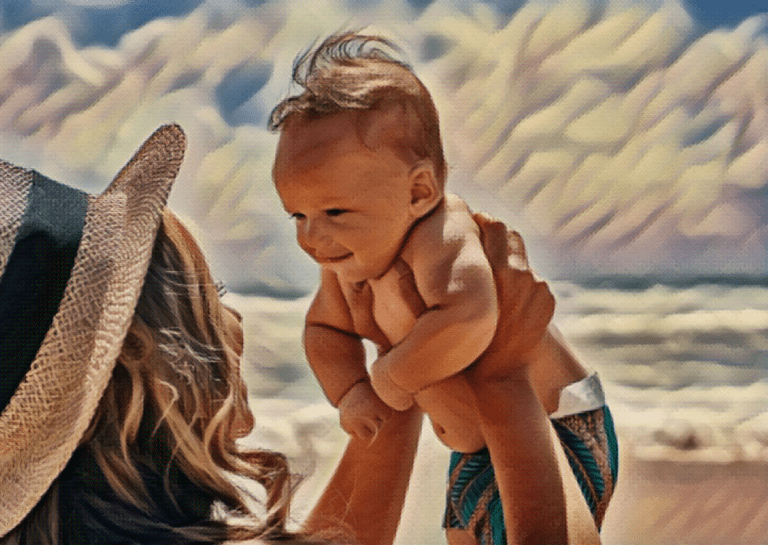Parenting can often feel like a constant cycle of learning all the things. But when the summer season rolls around, you deserve a respite and stress-free vacation time. With a toddler or newborn, these warm months become even more precious as you create new family memories and they experience significant moments and places for the first time.
You should be able to be present and enjoy those moments without worrying about small things. That’s why in this article, I’m going to cover what infants should wear during the summer so that you can pack a bag for vacation or plan outings with confidence and without the endless Google scrolling for information.
I’ll break down how heat affects babies and signs of overheating, what babies should wear in warmer weather, and expert tips on keeping your child cool during the hottest months of the year.
Table of contents
Understanding How Heat Affects Babies
Babies and young children don’t sweat as much as older children and adults, meaning they can’t cool down as effectively. Especially in young infants, the maturity of their built-in thermal regulation function, which regulates their body temperature, makes them prone to becoming too hot or cold.
With an already higher probability of being affected by the heat, scorching summer temperatures can heighten the dangers for a newborn baby’s health. Entering into the warmest months of the year, it’s essential to know and be able to recognize the signs of hyperthermia, known as overheating, in your child.
Of course, one of the most significant risks of high temperatures and sun exposure for your newborn’s safety is heat-related illnesses. Signs of overheating in infants include:
- Reddening of the skin.
- Becoming less active, overly tired, or going to sleep.
- Feeling warm to the touch.
- Being fussy.
- And having an elevated heart rate.
Overheating can lead to more serious conditions like heat rash, heatstroke, dehydration, and even cause the occurrence of SIDS, which is Sudden Infant Death Syndrome. If you notice symptoms of more serious conditions developing, it’s critical you take them to the hospital for medical treatment and evaluation.
What Clothing Newborns Should Wear In The Summer
With the risk to your newborn baby being considerable, it’s important to know what you can do as a parent to keep them safe. One of the key ways to keep your infant cool is to dress them in summer-appropriate clothing and fabrics. A light, breathable material like single-sheet cotton is best for those scorching summer months. In addition, it’s also recommended you dress your infant in light-colored onesies, especially if you’ll be outside. Lighter colors like white, grey, or pastels absorb less heat compared to darker colors.
While buying clothes for the summer months, you’ll notice the TOG listed, which stands for Thermal Overall Grade. Essentially, the TOG number lets you know what clothes best suit certain climates or temperatures. The numbers range from 0.5 to 3.0, with 0.5 best for warm temperatures and 3.0 best for winter months. The TOG can help you determine what to dress your newborn in based on temperature. This is covered a little more in-depth in this article on infant sleepwear.
Layers are typically recommended, but they’re likely not necessary if it’s over 75 degrees Fahrenheit. A short sleeve cotton bodysuit should do the trick. Another option to consider is using cloth diapers rather than disposable ones. Disposable diapers have a plastic layer that traps moisture, which can trap sweat in warmer weather and lead to diaper rash. Cloth diapers are cooler, which can increase your child’s comfort, and, as bonuses, are a choice that can save you money and are better for the environment.
Other Tips On Keeping Your Baby Cool In Hot Weather
You want to be sure you’re protecting your baby from too much sun exposure. It’s helpful for them to have a sun cap, even sunglasses, anything that can lead to a safer outing like a beach day. Small dabs of a natural mineral sunscreen can protect them from ultraviolet rays, which is a danger of sun exposure. UV rays are damaging for you and your baby, leading to pesky problems like sunburn, and exposure has a proven link to health issues like skin cancer. You can find more details and a comprehensive explanation in this article on the best sunscreen for you and your child.
Extra feeds can be helpful for babies during the summer months to keep them well hydrated. If you’re keeping them in a carrier or car seat and are placing blankets over the top to keep them in the shade, it’s important to make sure the blanket is lightweight and that you can see your child at all times. Using too heavy of a blanket or covering them completely can quickly lead to them getting too hot and you not being able to see if they’re in distress. Taking breaks from being outside is also wise, with an AC-controlled room offering respite from the heat.
It goes without saying, but as a reminder, you should never leave your baby in a car. Especially when it’s hot, it presents all kinds of dangers to their safety and wellbeing.
Conclusion
I hope this gives you some peace of mind as you gear up for a fun summer. Wearing light layers and materials, staying hydrated, and limiting sun exposure can help you feel confident in your parenting while creating special memories. If you ever have questions or concerns, it’s also important to speak to your pediatrician, who can give you personalized advice and insight.
